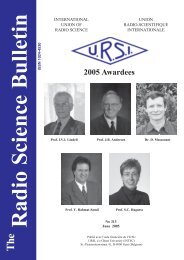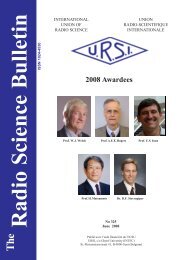December 2012 - URSI
December 2012 - URSI
December 2012 - URSI
You also want an ePaper? Increase the reach of your titles
YUMPU automatically turns print PDFs into web optimized ePapers that Google loves.
intensified on the days marked on the Calendar, and<br />
schedule balloon and rocket experiments accordingly<br />
if there are no other geophysical reasons for choice. In<br />
particular it is desirable to make rocket measurements of<br />
ionospheric characteristics on the same day at as many<br />
locations as possible; where feasible, experimenters<br />
should endeavor to launch rockets to monitor at least<br />
normal conditions on the Quarterly World Days (QWDs)<br />
or on RWDs, since these are also days when there will<br />
be maximum support from ground observations. Also,<br />
special efforts should be made to assure recording of<br />
telemetry on QWDs and Airglow and Aurora Periods<br />
of experiments on satellites and of experiments on<br />
spacecraft in orbit around the Sun.<br />
Meteor showers<br />
Of particular interest are both predicted and<br />
unexpected showers from the encounter with recent dust<br />
ejecta of comets (meteor outbursts). The period of activity,<br />
level of activity, and magnitude distributions need to be<br />
determined in order to provide ground truth for comet<br />
dust ejection and meteoroid stream dynamics models.<br />
Individual orbits of meteoroids can also provide insight<br />
into the ejection circumstances. If a new (1-2 hour duration)<br />
shower is observed due to the crossing of the 1-revolution<br />
dust trail of a (yet unknown) Earth threatening long-period<br />
comet, observers should pay particular attention to a correct<br />
determination of the radiant and time of peak activity in order<br />
to facilitate predictions of future encounters. Observations<br />
of meteor outbursts should be reported to the I.A.U. Minor<br />
Planet Center (mpc@cfa.harvard.edu) and International<br />
Meteor Organization (visual@imo.net). The activity curve,<br />
mean orbit, and particle size distribution of minor annual<br />
showers need to be characterised in order to understand<br />
their relationship to the dormant comets among near-Earth<br />
objects. Annual shower observations should be reported to<br />
national meteor organizations, or directly to the International<br />
Meteor Organization. Meteoroid orbits are collected by the<br />
IAU Meteor Data Center.<br />
The International Space Environment Service (ISES)<br />
is a permanent scientific service of the International Union<br />
of Radio Science (<strong>URSI</strong>), with the participation of the<br />
International Astronomical Union and the International<br />
Union of Geodesy and Geophysics. ISES adheres to the<br />
Federation of Astronomical and Geophysical Data Analysis<br />
Services (FAGS), now a part of the new World Data System<br />
(WDS), of the International Council of Scientific Unions<br />
(ICSU). ISES coordinates the international aspects of the<br />
world days program and rapid data interchange.<br />
This Calendar for 2013 has been drawn up by R. A.<br />
D. Fiori and H.E. Coffey, of the ISES Steering Committee,<br />
in association with spokesmen for the various scientific<br />
disciplines in SCOSTEP, IAGA and <strong>URSI</strong> and other<br />
ICSU organizations. Similar Calendars are issued annually<br />
beginning with the IGY, 1957-58, and are published in<br />
various widely available scientific publications. PDF<br />
versions of the past calendars are available online.<br />
Published for the International Council of Scientific<br />
Unions and with financial assistance of UNESCO for<br />
many years.<br />
Copies are available upon request to ISES Director, Dr.<br />
Terry Onsager, NOAA Space Weather Prediction Center, 325<br />
Broadway, Boulder, CO, 80305, USA, telephone +1-303-<br />
497-5713, FAX +1-303-497-3645, e-mail Terry.Onsager@<br />
noaa.gov, or ISES Secretary for World Days, Dr. Robyn<br />
Fiori, Geomagnetic Laboratory, Natural Resources Canada,<br />
2617 Anderson Road, Ottawa, Ontario, Canada, K1A 0E7,<br />
telephone +1-613-837-5137, FAX +1-613-824-9803, e-mail<br />
rfiori@NRCan.gc.ca. Beginning with the 2008 Calendar,<br />
all calendars are available only in digital form.<br />
The website for the International Geophysical<br />
Calendar, including recent versions, can be found here.<br />
46 The Radio Science Bulletin No 343 (<strong>December</strong> <strong>2012</strong>)
















